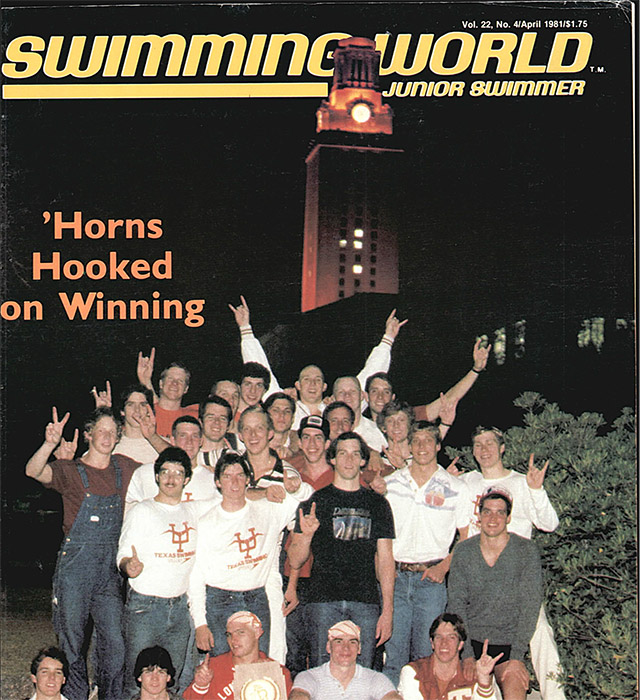The Night UT Swimmers Lit the Tower Themselves

The April 1981 cover of Swimming World magazine featured the first UT swimming and diving team to win the national championship. Photo courtesy of Swimming World
By Alex Wilkins
For Reporting Texas
A big white “1” glowed from the University of Texas Tower in March to celebrate the men’s swimming and diving team’s first national championship since 2010.
Head coach Eddie Reese has seen the tower lit 11 times for his team. It’s tradition — but he remembers a time when it wasn’t.
On March 28, 1981, the team earned its first-ever national championship at its home pool in Austin. Reese and the team visualized the tower lit burnt orange in honor of their accomplishment. It had been done each year football won the national title, in 1963, 1969 and 1970.
School administration said it was too expensive. So the team decided to make its own splash.
The tower lit up that night, 34 years ago, after Reese fought to give his swimmers the recognition they deserved. His swimmers and divers flipped the switches themselves. For the next 10 national titles at Texas, the university did it for them.
“When we first got here, this school had two sports: football and spring football,” Reese said after clinching this year’s national championship. “They just didn’t know what an accomplishment it was. But that’s all right. I think we’ve educated them.”
At the time, Reese was 39 years old. He had rebuilt a moribund Auburn program to second in the nation in six years. To get Texas to No. 1 took him only three.
Not only did the Longhorns win that year, they broke three American records, tallied five individual champions and finished with 14 All-Americans. Commotion and pride spilled out of the Texas Swimming Center, but the tower stood colorless less than a mile away.
Creating the symbolic 1 wasn’t easy. To black out the 148 windows needed, workers had to tape paper to each window, one by one. The process took 46 workers more than 200 hours, according to The Alcade magazine from January-February 1978. The labor alone cost $1,706 on top of the electricity bill.
Nonetheless, the school already had established that pride trumped price in the case of football. An NCAA swimming championship joined the official university list of lighting occasions in 1965, but the precedent had yet to be tested.
After being told no, the team devised a plan, and Reese handled precautions. He called police to offer honesty in hope of an exchange. A few teammates were going to run up the stairs and turn each light on themselves.
All the police said was, “We’ll be slow to respond,” Reese said.
During the 1981 championship, sophomore Clay Britt broke the longstanding American record for the 100-yard backstroke, then set a new one the next day. He remembers fondly a team picture taken that night in front of the beaming tower.
“I remember they weren’t going to light it, and then something happened,” Britt said with a laugh. “It was pretty amazing.”
As time weaved through four decades, Texas swimming and diving seemed impervious to change. Since arriving 37 years ago, Reese still coaches with assistant Kris Kubik, repeatedly brings in top recruiting classes and has won the conference championship 36 years in a row. No other team has ever won the Big 12. Reese is now tied with former Ohio State coach Mike Peppe for the most NCAA swimming championships, though Peppe retired after 33 years. Reese is still going strong.
“You could feel a dynasty beginning,” Britt said.
Each time the program seems to peak, it turns out to be merely a plot point on a rising incline. This year, when the Longhorns qualified six swimmers for the same championship final (100 butterfly), a new NCAA record, the competition was all but decided. Freshman Joseph Schooling became the first Texas swimmer to win the 100 and 200 butterfly in a career. He did it in one meet.
Sophomore Clark Smith won the 500-meter freestyle, and sophomore Will Licon won the 400 individual medley, giving the program a national championship in all 18 events since Reese arrived.
His coaching success transcends time. Reese has seen five different basketball coaches and five football coaches at Texas. Mack Brown and Rick Barnes, both highly regarded as Texas legends, would go to Reese for advice and his conditioning expertise.
“Eddie Reese, in my mind, has to be considered the best coach of any sport in the country,” Brown said.
Despite the numerous wins, accolades and championships, Reese remains self-effacing. Rather than focusing on his success, he remembers the snake collection Clay Britt had in his dorm more than 30 years ago. His key to success is simply treating people well each day. And at the end of each week, his swimmers go around the locker room and brag about each other. Britt said that happened in 1981, too.
The Reese legacy at Texas is not complete or even slowing. As soon as Texas qualified six swimmers for the same final and secured the win, he didn’t think about an 11th title. Instead, he began figuring out what techniques he needed to fix for next year. Once back in Austin to celebrate, he first made a stop at a sectional meet to watch two potential recruits.
“You don’t just sit around and enjoy it,” Reese said. “If you do, you’re just getting behind.”
When the sun when down that night in March, though, he paused with his team to take in the beauty of an illuminated “1” amid its burnt-orange backdrop. No one had to run up the tower’s stairs this time, but the end result looked just as it did in 1981. Same tower. Same coach. Same dynasty.